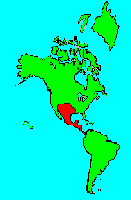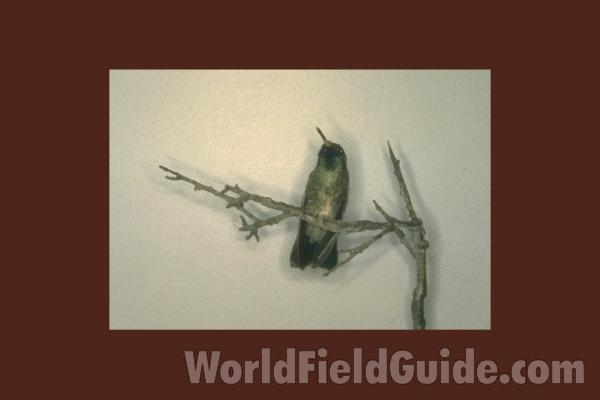SPECIES INFO
White Eared Hummingbird (Heliopaedica melanotis to Hylocharis leucotis to Basilinna leucotis to Hylocharis leucotis) is a Mexican species that occasionally is found as far north as Arizona and as far south as Nicaragua. The very noticeable white stripe from the eye backwards will help identify this species. The 3.7 inch male has a purple face, and his orange bill is dark tipped. The female is mostly brown with a pale breast marked with darker markings.
There are three subspecies. The nominate subspecies, Basilinna leucotis leucotis, is found from southern and central Mexico into Guatemala. The subspecies borealis is found in southern Arizona and northern Mexico. The subspecies pygymae is found in Honduras, El Salvador, and Nicaragua.
The image of the female in the John Gould painting shows a pale breast marked with brown, but the image of the female in Howell and Webb shows a female with a pale white upper breast marked with green spots. (The origin of the specimen in the Gould painting would suggest the subspecies Basilinna leucotis leucotis.)Naturally with so many species of hummingbirds, naturalists would like some divisions within this family. However, so far only two make sense, and this large group is the second group with the vast majority of the species.
The problem that taxonomists have faced is the common appearance of several unusual tail shapes in seemingly unrelated genera.
However, we have used several of these tail features to create artificial groups that will help in identification. This group contains species with somewhat normal tail shapes.
Hummingbirds (Family Trochilidae) are a family of 319 species of small birds that are well-known for their ability to hover. Prior to 1900, millions of these birds were exported from South America (primarily Colombia) and the Caribbean for use in jewelry in Europe and England. Many of the species are very brilliantly colored.
This family is nicely represented in Costa Rica where over 50 different species have been recorded.
Swifts and Hummingbirds (Order Apodiformes) are combined into a single order. Both families have excellent flying abilities. The swifts are known for their speed, and the hummingbirds for their ability to hover.
Clements in 2007 listed 100 swifts, 4 treeswifts, and 339 hummingbirds. (Total of 443 species.)
Aves contains about 8,650 different species of living birds known to science. Each year about one new species is discovered in some remote rain forest or remote island. In addition, scientists have been raising many subspecies to full species status which may raise the species count to 10,000. Birdlife recognizes 10,027 species as of 2011.
However, each year about one species goes extinct. The rate of extinction is increasing, and the rate of new discovery is decreasing, so that the number of bird species will soon begin to decline rapidly. Although different taxonomists would organize the birds differently, there are approximately twenty-seven orders of birds. These orders are broken down into about one hundred and fifty-five different families.
Recent research of the genetic structure of some of the shore birds and owls would indicate that the present organization of orders and families should have some modification.
The birds are a worldwide group of animals that are characterized by having the front limbs modified into wings that are used for flying. Perhaps the most unique feature of the birds is the feathers. These feathers are made up of a central support called a quill and a series of small filaments that are hooked together as barbs.
For many years it was believed that Archaeopteryx discovered in Bavaria was the oldest bird from about 150 million years ago. However, in l986, Sankar Chattterjee, a Texas paleontologist, reportedly discovered a bird in the genus Protoavis that lived about 225 million years ago.
When this project was begun in 1978, we used Austin & Singer for bird taxonomy. Since then, we have adopted many changes, but have kept some older concepts that are still found widely in the literature. Recently, we have used Clements and Howard & Moore. Very recently, we have used Monroe and Sibley for the higher taxonomy of the perching birds.
Backboned Animals (Phylum Chordata) are the most advanced group of animals on earth. These animals are characterized by having a spinal cord or backbone. Most members have a clearly defined brain that controls the organism through a spinal cord. Fish, amphibians, reptiles, birds, and mammals are in this phylum.
Currently, some taxonomists believe that the fish should be divided into two groups (sharks and regular fishes) and that there are some other primitive groups in the phylum such as hagfish or lampreys.
Animal Kingdom contains numerous organisms that feed on other animals or plants. Included in the animal kingdom are the lower marine invertebrates such as sponges and corals, the jointed legged animals such as insects and spiders, and the backboned animals such as fish, amphibians, reptiles, birds, and mammals.



